
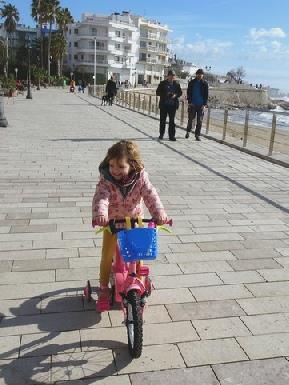
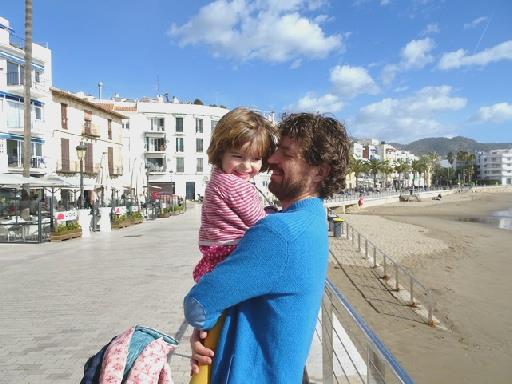
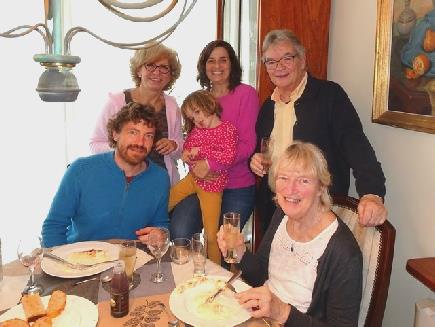

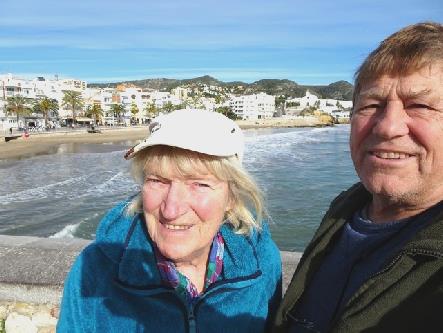
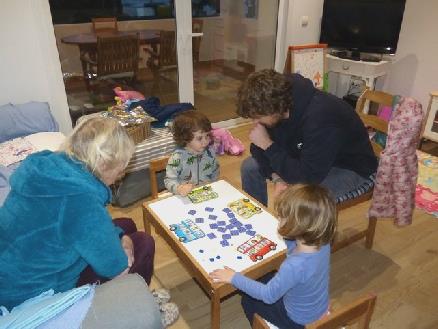

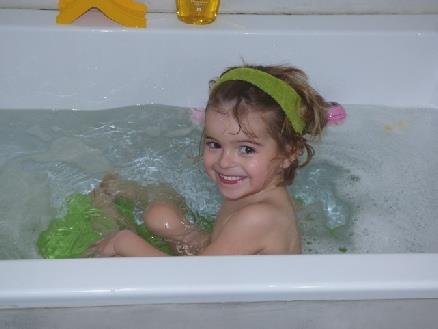
Rita and Tom on the promenade at Sitges
With Mar’s Dad and his wife at Vilanova
Sitges often has lovely skies
Rita with cousin Noah, and in her element in water!
We walked across the tarmac to the small airport building, where we soon collected our bags. We then had to wait a long time in the queue to get our hire car, a little white Skoda.
Our first impressions of la Palma - ' la Isla Bonita,' the 'pretty isle' - were of a steep volcanic island. Although there were clouds over the sea, the sky was blue as we drove on passing banana plantations, bougainvillea, palm trees, almond blossom and cacti - including the 'droopy swans'. Certainly the 'pretty isle'.
We were driving south for the first of our two accommodations, this one near the town of Fuencaliente. We weren't due in until 3.00pm, so stopped in the town to shop, as the time was just after 2.00 (we think!)
We then drove 5km down a narrow road of hairpin bends, stopping still high above the sea at what we took to be our property.
Apart from 4 large pots of bright geraniums, it all looked a bit uncared for. We ascended a rough cobbled path to the house, which was all locked up. Not knowing what to do, Adrian phoned the number he had, and talked to a gentleman who spoke some English, trying to explain that we were at the house. We ate the rest of our lunchtime rolls before driving up to the end of the road, then Adrian phoned again, and we waited. After a while, we walked back down to the car, and I queried whether we were at the right property. There were no names on either the roads or the houses. We perused the photo we had of the house - it looked similar, but we decided it was not the one. We drove back to another vertiginous road, and sure enough, we came to 'our' property, Casa el Mirador, where we met the nice owner. He showed us over the lovely house - very smart and well cared for. Just as he was leaving, he looked at our booking slip. Oh No! This smart house wasn't ours - that was the far simpler accommodation below!
He showed us over that - it was fine, and far more what we had been expecting! The view from high above the sea was wonderful. Everything was very clean and attractive.
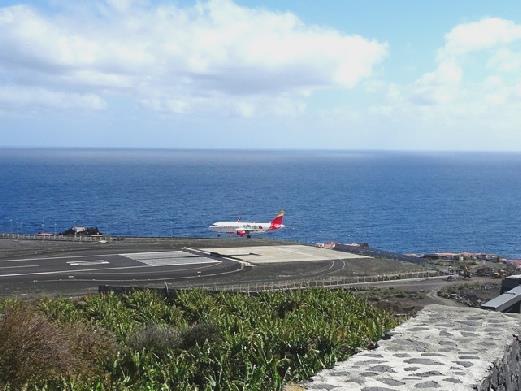
La Palma airport
We said goodbye, unloaded our stuff from the car, and relaxed with a cup of tea, sitting outside.
When we were a bit more organised, I made a simple omelet for supper, which we enjoyed with a bottle of bubbly.
Later we played yahtzee, where I scored the highest score ever - throwing 3 yahtzees - unheard of, and rarely have I got just one!
After our early start, and with me having had very little sleep, we went to bed at 9.30. Or was it 10.30?
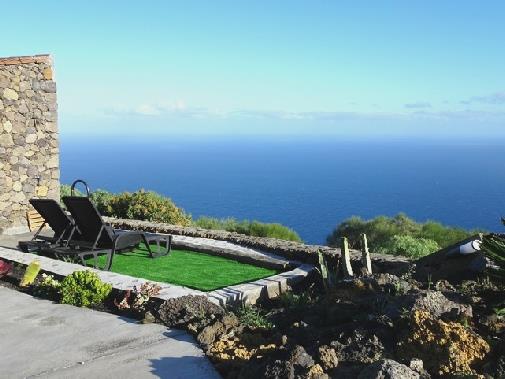
Casa el Mirador
Thursday 9th February To the extreme south of la Palma 30 km
A relaxing morning. We tried out the shower (my pet hate) on this sunny but windy morning. I caught up with the diary, stopping for our 'elevenses', sitting on the relaxer chairs on the artificial lawn. We realised that we have a view to Mt Teide on Tenerife. We still weren't sure what time it was!
We ate lunch on the patio, while little lizards scuttled around, and a Siamese cat came to visit.
We left at 1.30 (or 2.30), driving south. We were near the southernmost tip of the island, but just before the lighthouse, we turned off on a rough lava track to the beach. When the car crunched on the rocks underneath, we thought it best to turn round! White flowers, and later yellow ones, looked stunning against the black rock.
We drove on towards the lighthouse, turning off onto another unmade, but smoother, road towards Las Cabras beach. We stopped before then at a delightful cove of black soil, beneath 3 large wind turbines.

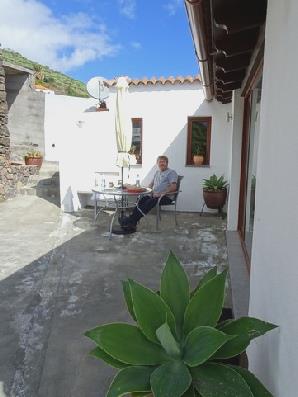
A Siamese cat comes to watch us having lunch
Waves were splashing up between the arches of rock – a really superb place. Adrian wandered around while I sat on the sand. Apart from a few feathery pink flowers, the soil was quite barren. We drove on a bit further to Las Cabras beach – another little cove where a pool had been made at the edge of the sea.
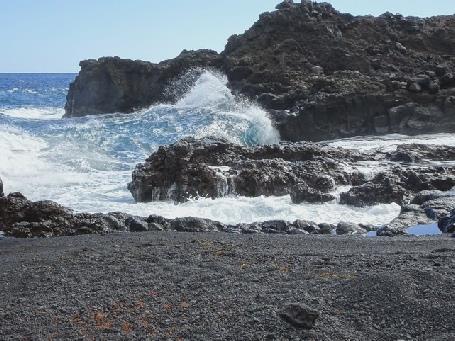
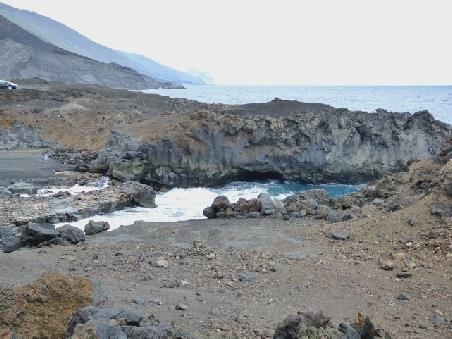
Rough waves pound a black sand beach
We drove on to the lighthouse – actually two, a stone one and newer stripy one, at Punta de Fuencaliente. We stopped by a little beach where there was a conglomeration of attractive fishing boats with the fishermen's huts behind them.

Las Cabras beach
Beside the lighthouse was a self guided walk around the attractively situated salt pans. We saw one or two birds as we walked around - ruddy turnstones. All was quiet now, as salt is only harvested in summer, but we did look in at the warehouse, where salt was being loaded up.
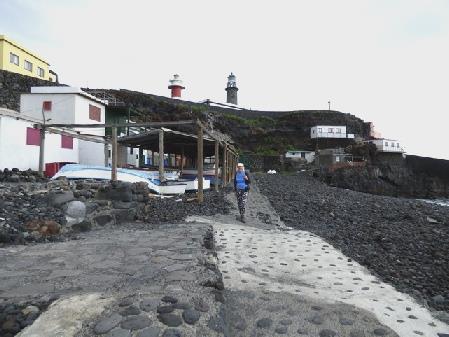
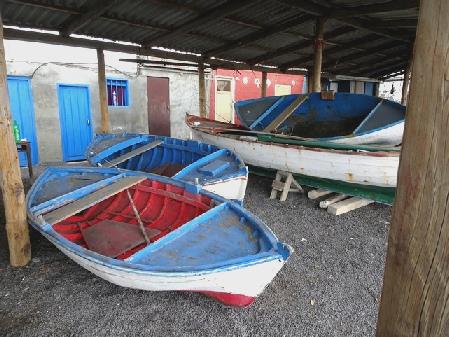
The little beach beside the lighthouse
Now we drove back to Fuencaliente, where we went into little Supermarket Betty, to buy one or two things for tonight, including a small cucumber, which I'd mistaken for a courgette! I'd been surprised to see one, when they are in short supply in Britain because of the bad harvest in Spain!
We got back at 5.30 (or 6.30). We realised why we hadn't noticed Mt Teide last night – there was again a bank of cloud at sea level.
After supper – rather chewy tinned octopus - we started working on the website.
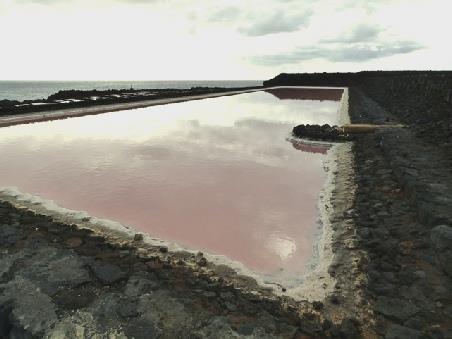
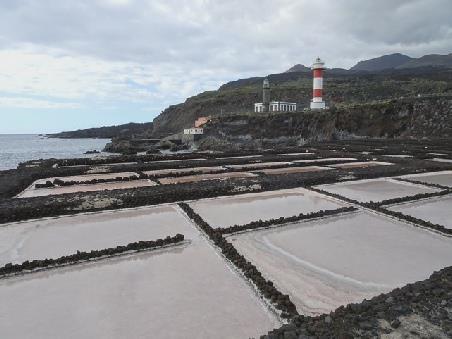
The salt pans by the lighthouse
Friday 10th February Right around the southern tip 37km
It was a bit cloudier at first, but we still enjoyed breakfast with our wonderful view.
After early coffee, sitting on the sunbeds, we left soon after 10.30.
We drove south again, planning to take the road we'd unexpectedly passed yesterday to Tenegua volcano. When we reached it, it was as we feared- not for cars, just a track. Having come this far, we thought that we'd continue on past the lighthouse.
Just afterwards we came to a beach of black sand, Playa Echentive, with good stone steps down to it. It was a long way, but we decided to give it a go. At the bottom, cinder paths edged by large rocks radiated right across the beach. There was virtually nobody else around. A clear pool of salt water stood below an emerging lava tube in the sheer rock face. There was a 200m tunnel here which was built in the early 2000's to access the Fuente Santa (hot water spring) which had flowed onto the beach until the Tenegua volcano erupted in 1677. Having reached the spring, the authorities now don't seem to know what to do with it!

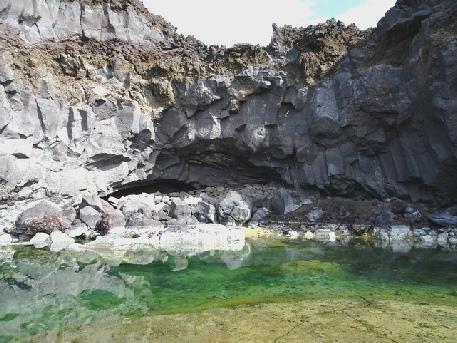
The far south of La Palma and a lava tube emerges on to the beach
We carried on up the coast, through constant banana plantations, calling in at Zamora Cove, where there was a busy restaurant overlooking the sea. Again large aquamarine waves crashed in, and onto the black rock stacks out to sea. It was still windy. We drove on to the end of the road near Las Indias. Then it was time to ascend the long hairpins.
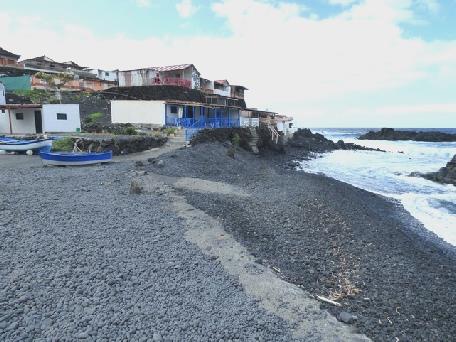
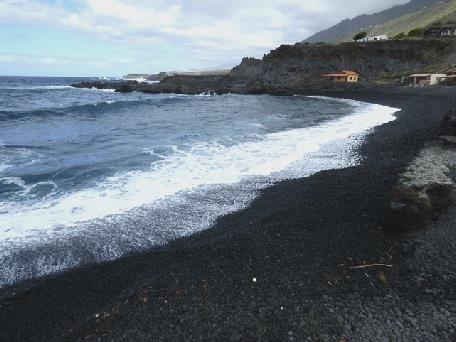
Punta Larga
At the top, we found the car park for San Antonio volcano, but decided to visit that another day. We stopped In Fuencaliente, to get some money and to buy some rolls from a little bakers/cafe, arriving back at 3.15.
We thought that we'd try out the decrepit vertical cylinder washing machine which is situated just outside. The cycle took an absolute age, but the things were nowhere near spun dry. We hung them on the airer, which we'd brought inside.
The full moon shone down on the sea while we had tea.

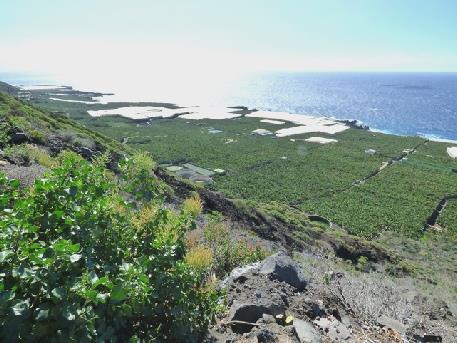
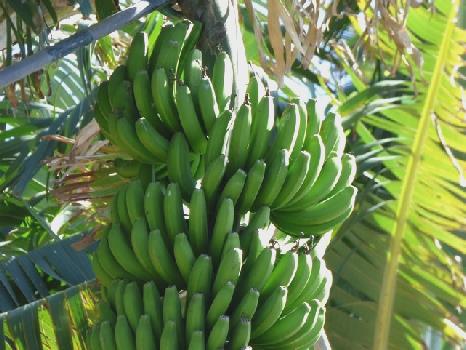
Have a banana!

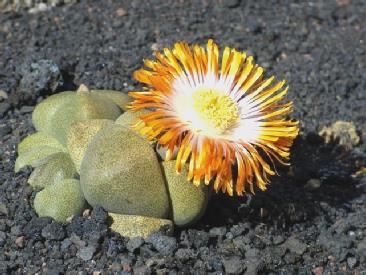

Flowering cacti in the garden, then the full moon
Saturday 11th February Things don't quite work out, as we drive north 71 km
It rained heavily in the night, and in the morning we found that we had no electricity. Electric man Adrian discovered that it was only us, not a power cut, and fixed it!
The day was mixed, with blue sky and sun but also showers of rain. Better than the snow that England was having as we discovered when we spoke on the phone to Emma.
We decided not to visit the volcano today, with the prospect of rain, so set off northwards towards Santa Cruz, taking the higher, winding road. Everywhere looked really bright after the rain, especially the white, purple and yellow flowers.
We drove through Fuencaliente, turning off when we saw a sign to a viewpoint, but realised that you had to walk to the top of a crater for the view!
It was mizzling when we stopped at Mazo, which had some unbelievably steep streets. We located the weekend indoor market and went in to buy some very fresh veg. The market was quite small, but also had some exquisite needlecraft.
We peeped into San Blas church, which dates from 1512, in its lovely location above the sea. The nearby San Blas restaurant, mentioned in Lonely Planet, was closed – only the tiny bar was open, with people smoking.
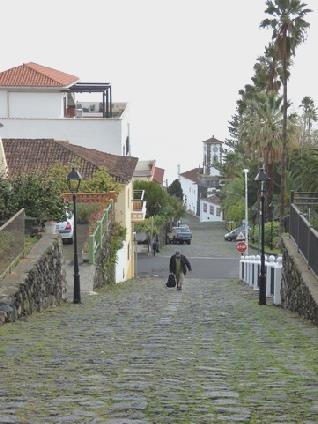
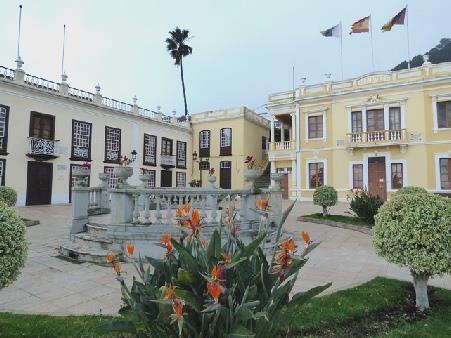
Mazo town hall and amazingly steep streets
We had been hoping to have lunch there, but just used the loos and drove on towards Santa Cruz, turning off to the pleasant resort of los Canjacos, with its wide black sand beach. One or two people were even in swimming.
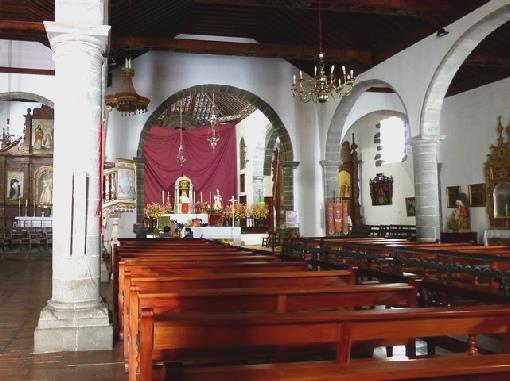
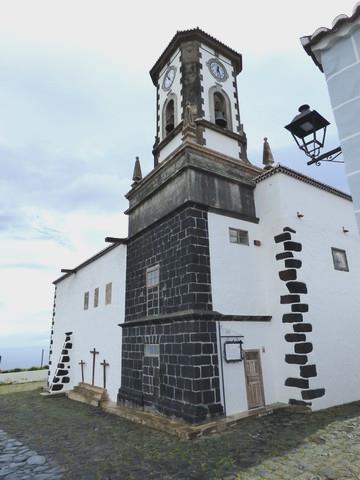
San Blas church, Mazo
We located El Pulpo restaurant, again mentioned in Lonely Planet, right beside the beach, and sat outside to eat. My fish soup was very good, but Adrian's tuna salad was full of onion.
After this, we followed the sat-nav through the labyrinth of banana plantations to find the road south. We were heading for Belmaco Ecological Park to see the petroglyphs which date from 150AD. We reached it at 3 o'clock. We were able to park, and were just about to descend the steps when we had a few drops of rain, and then we saw that it closed at 3.00pm!
We headed back, stopping in Fuencaliente to shop in 'Superdino' for water, milk, wine and bread. It rained more after we got back. Inspired by the meal we had with Mar’s dad, we ate mussels for supper, which were really good.
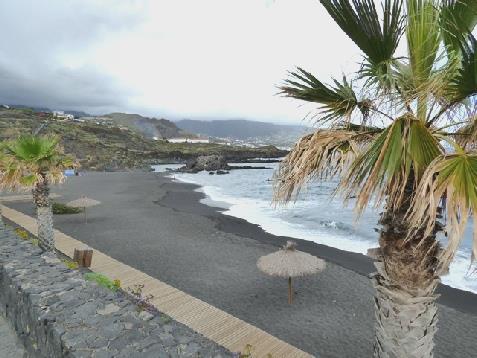
Los Canjacos beach
Sunday 12th February Too windy for comfort 114km
It was really windy in the night, causing the stove cover to flap constantly. The day stayed windy, but dry, with the temperature about 18°C. The sun shone dramatically through the clouds on to the sea while we ate our boiled egg for breakfast.
We enjoyed hearing Dolly Parton's sister Stella on Good Morning Sunday, although the reception was erratic. Afterwards, Anneke Rice was presenting Sunday Love Songs, which was preferable to Steve Wright!
We left just after 10.00, with our lunch, after the difficulties of yesterday.
We drove through Fuencaliente as ever, then took the road up the west coast. We stopped at el Charco viewpoint for coffee, and, as all day today, there was a strong cool wind.
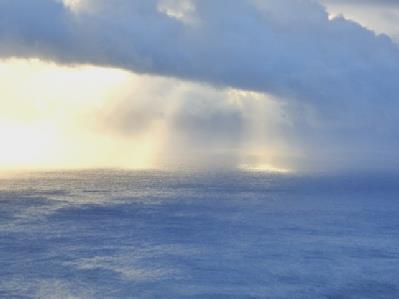
The sun shines down dramatically onto the sea
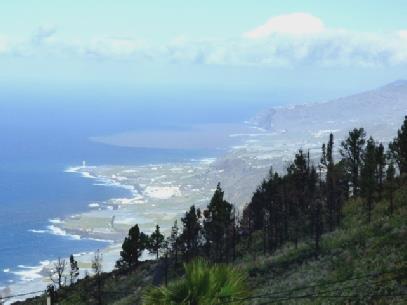
When we reached Puerto Naos, the west coast resort, we had to descend hundreds of feet amongst the banana plantations. It was far too windy for me to enjoy, and the difficulty of one-way streets meant that we didn't stop long. Los Cancajos, the 'resort' on the eastern coast had seemed much more attractive.
Looking down from el Charco viewpoint
A little way north was Tazacorte, a far more genuine town.
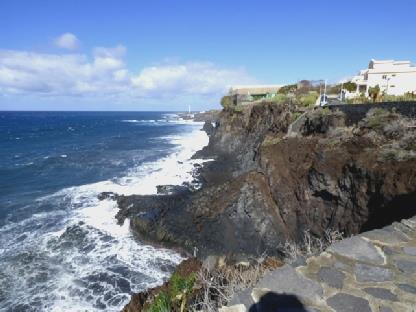
The view north from Puerto Naos
We stopped at Puerto Tazacorte, which was really busy on this Sunday lunchtime. It had a pleasant feel, sandwiched in the space beneath the huge vertical cliff walls. It was blowy here too, so after a little walk around, we sat in the car to eat our lunch, beside the Angustius River, whose brown waters surged out to sea, discolouring the water for some distance. It must have been a rare sight, judging by the numbers of people standing and looking.
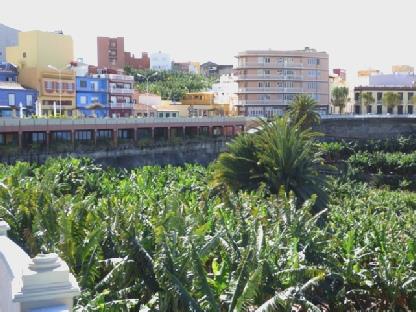
Banana plantations from the town right down to the sea at Tazacorte
We now headed for Los Llanos, where we followed a road into Taburiente National Park, but it was a no-go as the road was closed. We continued through El Paso to take the road which went into the park to La Combrecita lookout, but a sign said that it was closed too. When we visited the Visitors Centre, we found out that all roads and walks in the park are closed today because of the high winds. The centre had a lot of information, and some great relief maps of the island. Before that, we'd looked into the well loved little church of Virgin of the Pines, set in isolation amongst the forests of pines, with the massive walls of the caldera around it.
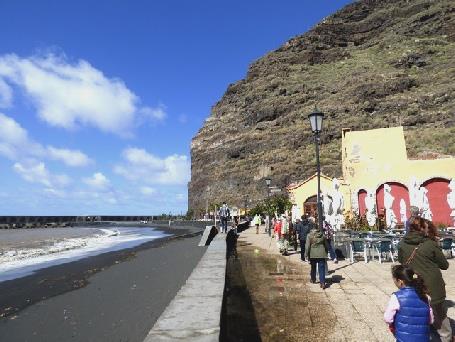
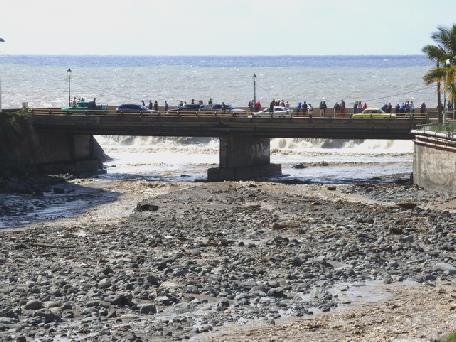
The brown Angustius River flows into the sea at Puerto Tazacorte
We now drove the old road east but when we reached El Pilar recreation area at 1465m (4800ft), it was all in cloud. There was no view, and few people.
We stopped at another viewpoint, where we could see down to the coast around Santa Cruz, but here the wind was really powerful. Debris was often strewn across the road.
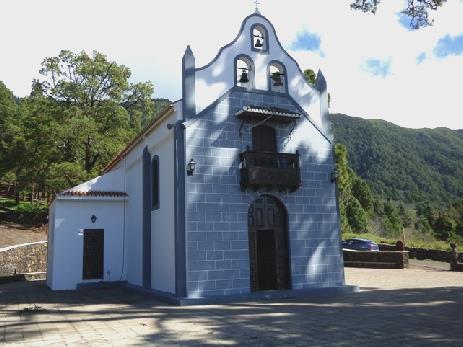
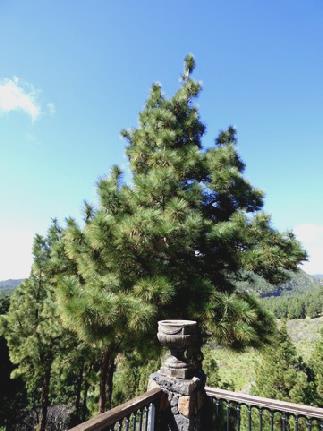
The hermitage church of the virgin of the pines
We drove back to our place, arriving about 4.30 – just time for a cup of tea sitting in a sheltered spot outside.
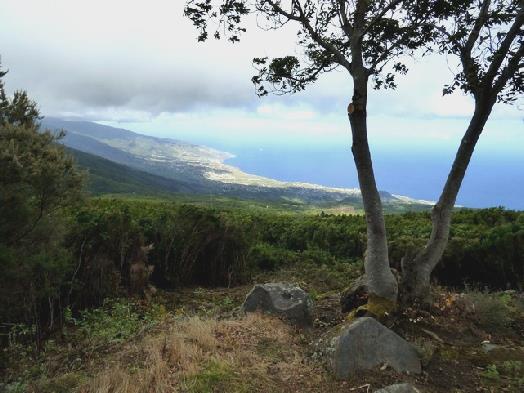
Looking down towards Santa Cruz
Monday 13th February Santa Cruz at last, some petroglyphs and a nice beach 89 km
Thank goodness the wind had stopped blowing, and we could look out to a calm sea.
We left before 10 o'clock, heading for Belmaco caves, and this time we were in luck! We were virtually the only visitors, and after paying our €2 each to a lady who spoke no English, we wandered around this attractive area, squashed beneath a hairpin bend in the road. It wasn't at all what we had been expecting - the 'cave' was a long overhang in the rock, where people are supposed to have lived 2,000 years ago. The petroglyphs were barely visible on the rocks. We wandered around this verdant oasis, along the rough paths and up and down uneven stone steps, often with no handrail. Boards did tell you about the area, and there was a small museum with a nice model of what the inhabited cave would have looked like. It was really peaceful walking round, with just bird song. Rock pigeons flew into crevices in the rock face. A surprising and lovely visit.
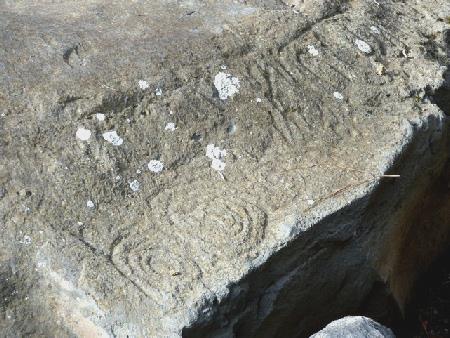
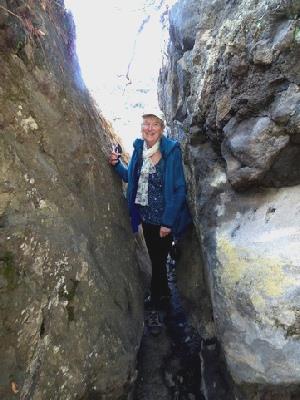
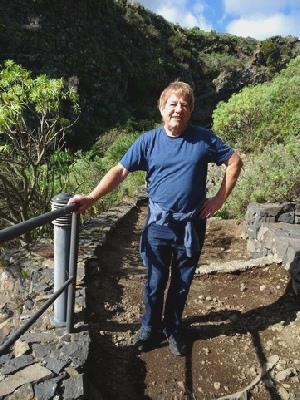
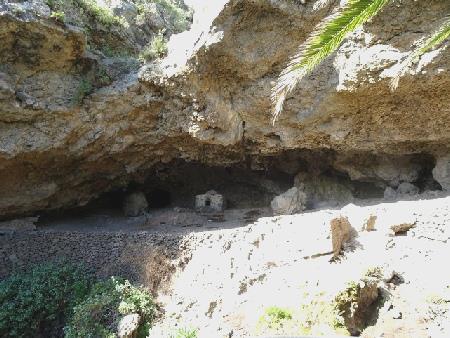
Belmaco caves
Near here, we came to a little cafe with outside seating where we enjoyed the 'daily menu'. For €7 we each had superb vegetable soup, Spanish omelet with chips (too much for me), icecream and a beer! Right in the centre of Santa Cruz! A lorry with a platform lift was hanging decorations up above us- presumably for Carnival. Although we were having lunch, most other people were just having coffee!
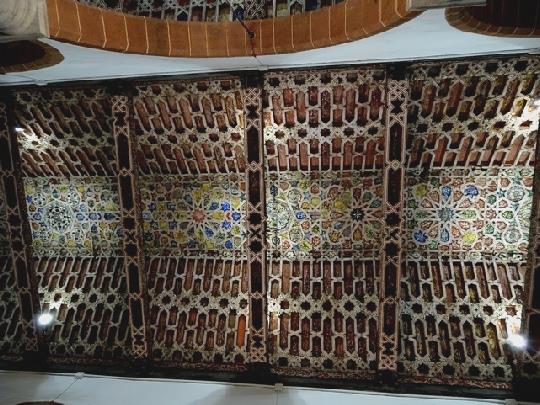

The church of El Salvador, Santa Cruz, with its intricate carved ceiling
We were now fuelled for our uphill walk back to the car, stopping to shop in 'Spar' on the way.
Now 2.30, we had a hairy drive up to the sanctuary of the Virgin of las Nieves, a few steep miles out of town. This is a place of pilgrimage, and unfortunately on the tourist route. A large coachload of French people were queueing to use the one loo!
The church was large, and really long, very ornate and again with a carved wooden ceiling. Outside all but the front was painted white, with overhanging balconies.

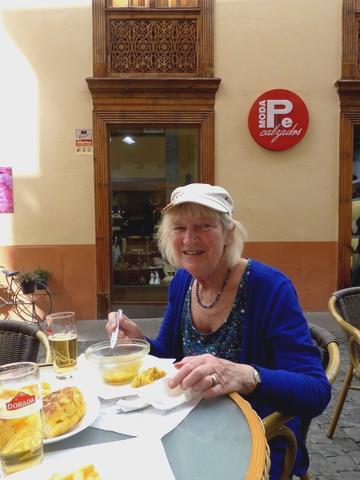
Eating lunch while they hang decorations above us!
From here we headed down to Los Cancajos which we had visited the other day. This time we walked along the promenade in front of all the apartments but looking seawards, there were black lava coves with the blue water swirling in.


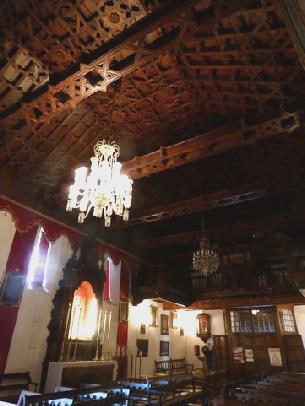

The virgin of Las Nieves church
We had one more stop on the way back - driving down several miles of steep roads to Playa Blanca. It was worth it to find a delightful little cove of, not white sand, but, as Lonely Planet put it, pepper and salt, but I would say with more pepper! The white particles are apparently from crustaceans.
Black lava rocks fringed the cove, which was edged with attractive simple little beach homes. A conglomeration of small boats stood on the beach.

Los Cancajos
Now 5.00pm, we headed back, arriving at 5.30.
We were really saddened to receive an email from Steve in Canada to say that his dad Dave had just died.
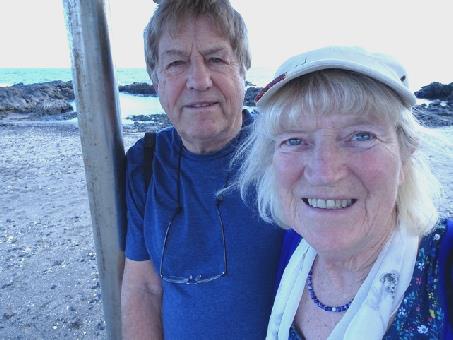

Playa Blanca
Tuesday 14th February San Antonio volcano 22 km
A dramatic sun over the sea again.
We exchanged Valentines cards (yes, even after all these years!)
We left at 10.45, after coffee on the relaxer chairs, although it was a bit windy.
This was the day to visit San Antonio volcano, near Fuencaliente.
A new Visitors Centre had been built, so we paid our €5 each and looked round at the various maps and information. Adrian couldn't resist buying another map of La Palma. After watching a video in English about the area, in a posh cinema, we walked out along the pathway to see the volcano which had erupted in 1677. The rough path was along a ridge sandwiched between the volcano and the steep slope down towards the sea – not the best for me, especially as it was windy. There were a lot of visitors, some folk were wearing shorts and T shirts – that wouldn't have suited me either!
We walked for some way around the volcano, but stopped before it became too vertiginous!

We drove back to Fuencaliente, stopping by the square where there was a restored ancient wine press, and the church of St Antonio, which we peeped into.
We ate lunch in the car nearby before driving up into the hills above Fuencaliente. We stopped to walk through the pines along a rough path of volcanic rock, set initially between low stone walls. It was part of the GR path system, with signposts saying 16km & 22 km – we weren't going that far!
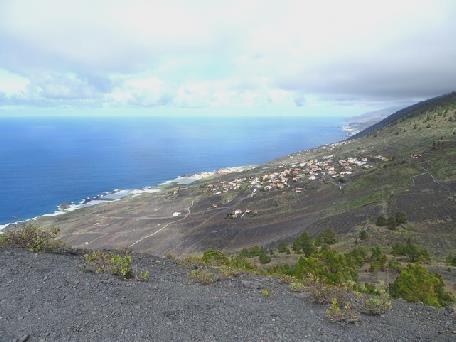
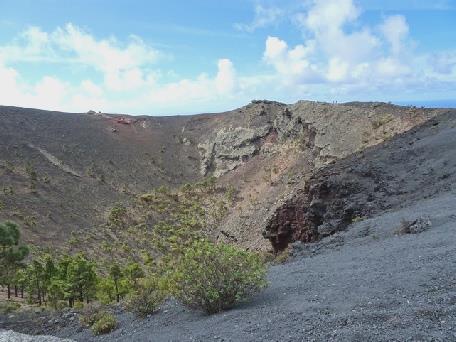
San Antonio volcano and the view down to the sea

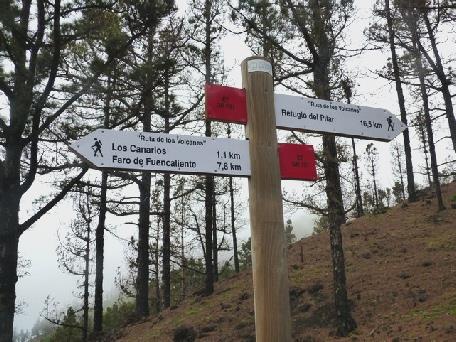
Walking in the forest above Fuencaliente
Before arriving back at our place, we drove down to the initial house which we had thought was ours. We found that it was several hundred feet directly below us, but hidden from view by a bluff.
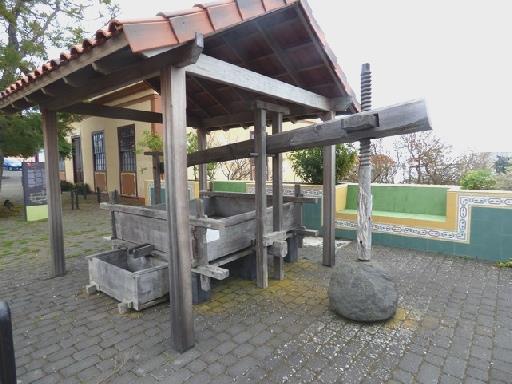
Old wine press at Fuencaliente
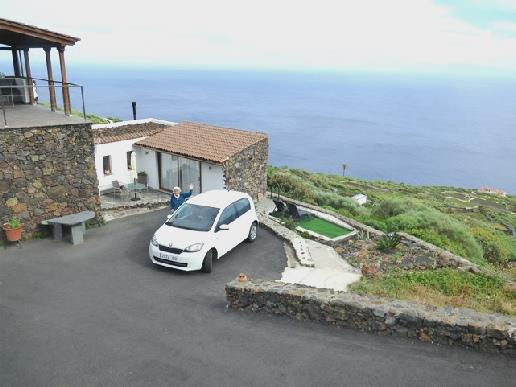
We arrive back at ‘our’ place at Las Caletas
Wednesday 15th February Real sun at last, after a dodgy start! 144 km
A wet and windy morning!
As we left at 9.45, the song 'why does it always rain on me' played on our ipod for the second time this morning!
The rain was bad enough, but then we went into thick fog, which was much worse.
As we drove north, the fog cleared and we were back to rain.
This was our last day from our southern accommodation as tomorrow we move to one in the north for 5 days. Today we were exploring up the east coast past Santa Cruz.
We stopped just before Santa Cruz to have our tea/coffee beside the sea. A couple walking past spoke to Adrian. When Adrian bemoaned the weather the chap said 'it's OK'.


Looking to Santa Cruz
Crossing the steep, green ravines
We drove back down the gorge towards Los Sauces. There was an amazing bridge across the valley built in 2004. It was really peaceful here - more so than further into the forest, and even better, the sun was shining really warmly. There was a pedestrian path beside the road, with occasional exercise machines! We saw a Canary brimstone. A wonderful stop.
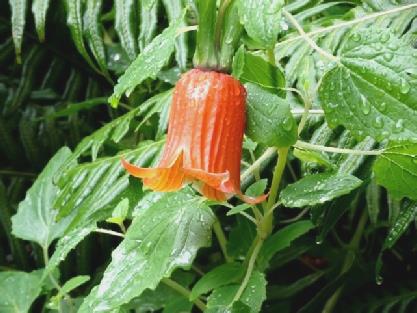
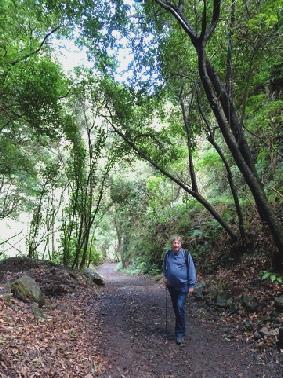
Canarian bellflower
Walking in Los Tilos
We drove on to Los Sauces, where we stopped at the main square by the enormous church, named Montserrat, after the one near Barcelona, which we have visited several times. Many Catalans settled here in the past. The church was closed, and had no name outside. We enjoyed the strelitzia flowers, and wandering around in the hot (!!) sun.
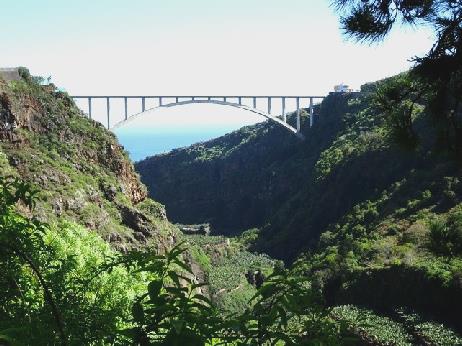
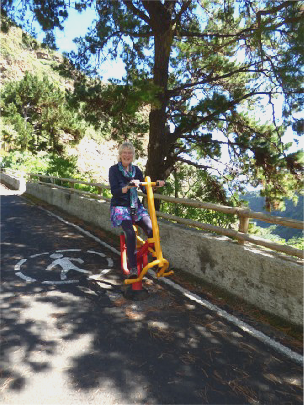
Wonderful Los Tilos bridge at Los Sauces
Exercising on the way!
From here we zigzagged down through constant banana plantations to Charco Azul. We walked down many steps to the attractive pools set into the black rocks. Several people, notably Germans, were enjoying the sun and one or two were in the water. It looked inviting.

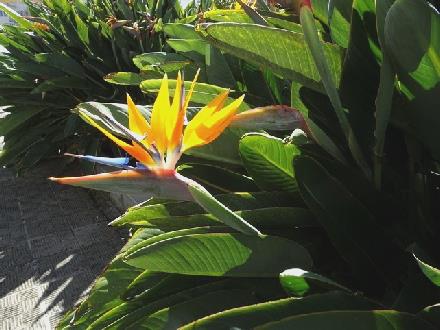
Strelitzia outside Montserrat church, Los Sauces
We drove on to nearby San Andres, a pretty little town above the sea. The cobbled roads were incredibly steep. The huge white painted church wasn't open, but the place was very peaceful, and again hot!
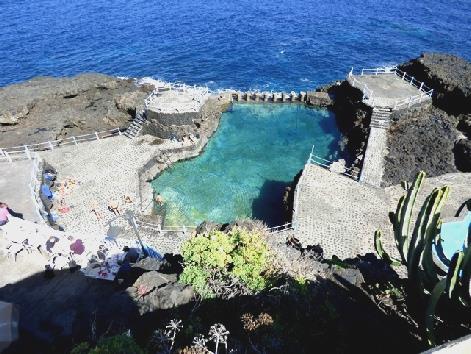
Charco Azul
We started driving south, turning off at Puntallana on constant wiggles for a really long way, stopping at the car park to Nogales beach, which was still hundreds of feet of sheer cliff below! We didn't go any further!
We took another loop off the main road, but it was only a way through all the banana plantations. We continued past Santa Cruz, stopping soon afterwards to shop in Lidl, and then to get some fuel.
As we continued south, it became cloudy and we came into mizzzle and fog. It was a bit better by the time we got to the house at 5.50 for our last night at this property. Adrian spoke to the couple in the other house.
We were very pleased to receive an email from Ed to say that Matt & Marion's little boy had been born. He looked beautiful on the photos.
It rained later, and again in the night.
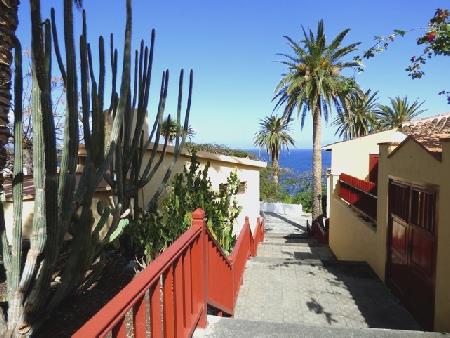
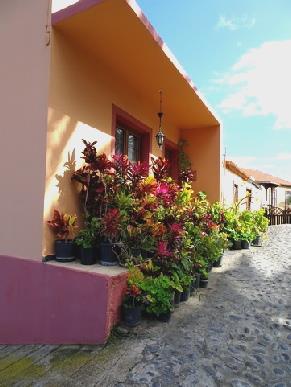
Pretty San Andres
Thursday 16th February On to our other property 86 km
As we travelled up the west coast to Puntagorda, in the north, there was some sun and some cloud. The yellow dandelion type flowers on the giant plants looked really bright.
We had to wait a long time for roadworks as an excavator moved earth on the hillside above.
We found a place to have coffee sitting on a hummock above Tazacorte. It was peaceful, with just birds, including two hawks. Adrian decided that the cloud was too low to drive to la Combrecita viewpoint, so we hope for clearer weather tomorrow.
We took a steeper than ever road from El Paso to the large, modern town of Los Llanos.
After that, we followed many zigzags to cross the Barranco los Angustius, which today had just a trickle of water, unlike the surging brown river of the other day. The road then rises 400m vertically to where we stopped at Mirador El Time and Adrian bought the T-shirt! We also bought a little Pinocchio toy for new baby Ossian.
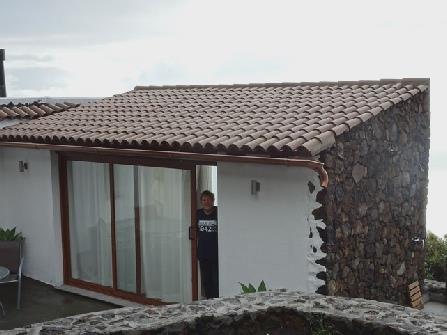
Farewell to Casa el Mirador
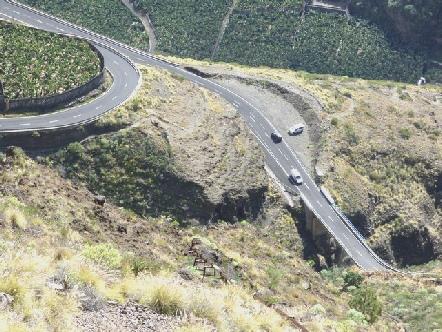
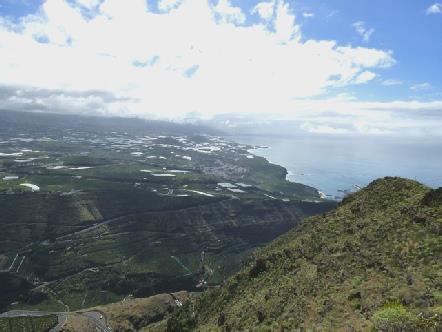
The view down from Mirador El Time
We drove back through the dense vegetation with sheer rocks scattered with caves.
We looked out from Miraflores lookout, before stopping at Spar to get some bread, and then making for 'our' house.


What a place for a port!
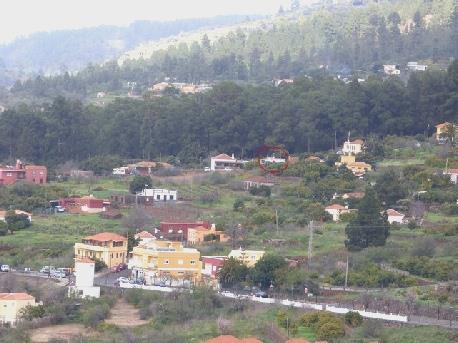
Our house (circled near centre), Puntagorda
Friday 17th February To the top of the world 69 km
How wonderful to look out to a blue sky!
We put in a load of washing, which was more successful than the last lot!
We ate breakfast outside, although the sun hadn't reached us, and spent the morning enjoying our new surroundings.
We sat outside the front door to enjoy elevenses in the sun, looking across to the orange trees, and feeling rather Spanish.
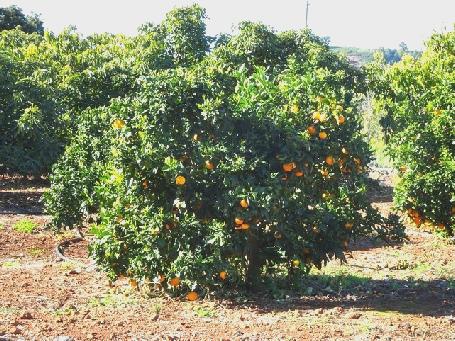
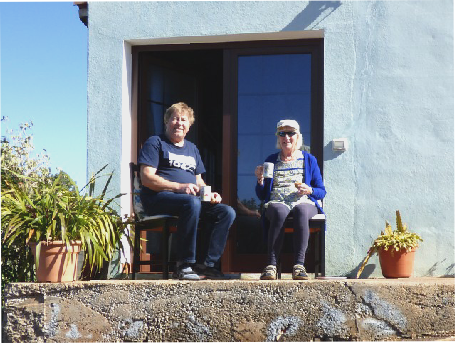
Elevenses, looking across to the orange trees
We left at 1.45, descending to the main road, which didn't seem so dreadful on the way down.
We turned off onto a minor road, which had lots of vines growing amongst the pines. We stopped to have a short walk under the pine trees, enjoying the smell of the warm sun on the needles.


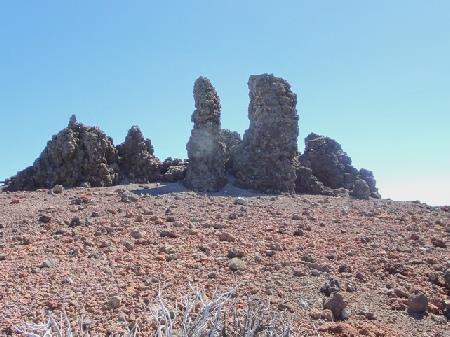

Roque de los Muchachos, the highest point on la Palma, and the largest observatory in Europe
Looking into Taburiente Caldera from Roque de los Muchachos
When we got back to Puntagorda, we stopped to shop in a small Maxi Co-op before driving on a bit to locate the weekend market venue. We were surprised that it was adjacent to a forested park – the end of which is behind our property. There were picnic areas and walks in the park, a really pleasant area. Opposite were three walkways made to view the huge chasm below. The end of each walkway was of glass at the sides and below – I just had a quick peep!
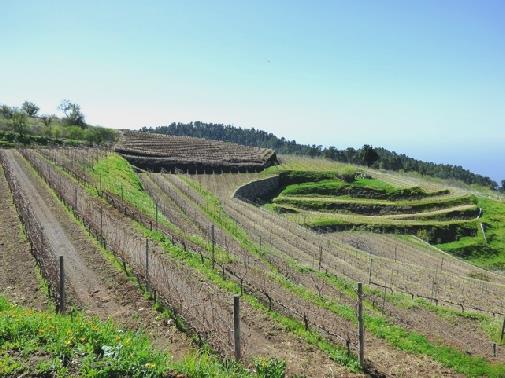
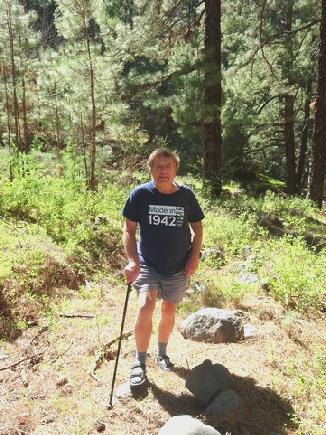
Pine trees and vines near Puntagorda
Back at the house, we enjoyed a cup of tea in the warm sunshine and later a beer in the last of the sun.
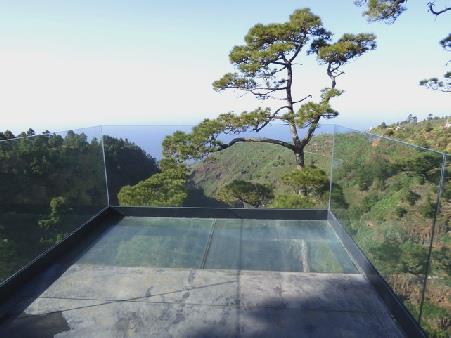
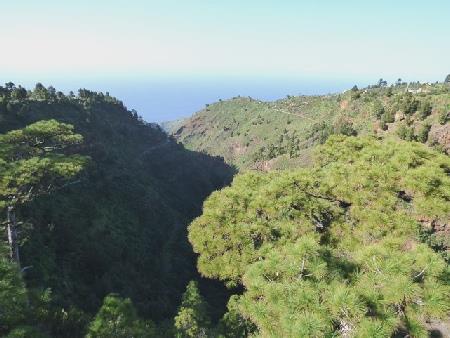
The glass floored viewing platform, Puntagorda
Saturday 18th February Interesting but difficult roads in the north east 105 km
It had been warm in the night, but the morning started cool, with a pinky/blue sky.
Today we wanted to explore the north east of the island, so left at 9.20, initially following yesterday's route, but turning off onto a 'white' road from Hoya Grande to La Mata.
We rejoined the main road to Roque Faro, where we couldn't find anything to see, then tuned off again onto another white road, which wiggled constantly. We were driving through steep pine forests very high up. We stopped at Mirador de las Mimbreras. It was an amazing road, very narrow, through the vertical forested slopes.
At bedtime we looked out at the stars, which were good.
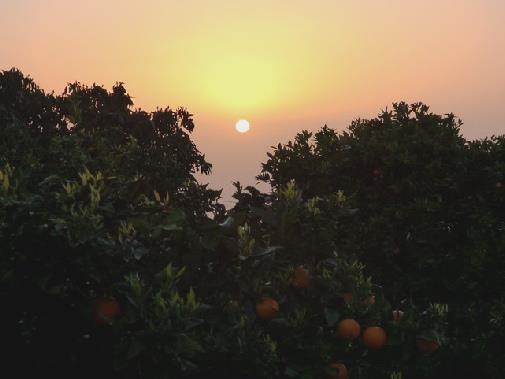
The sun goes down over the orange trees opposite
We came to 3 single lane tunnels hewn through the rock. Just before the third, there was a large rock fall, which almost blocked the road.
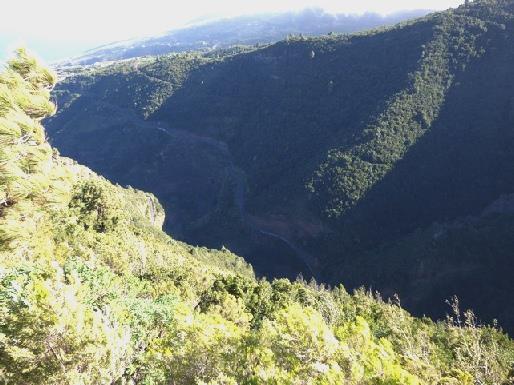
Driving here is not for the faint hearted
Just beyond the tunnel, we came to a picnic/barbecue area, with picnic tables set individually in the rock. Each had a sink, and there were even toilets here. A chicken was there to greet us, obviously knowing that this was a good place to get scraps, but at this moment, there was just us, stopping for coffee. On the other side of the road was a fuente – a natural spring.
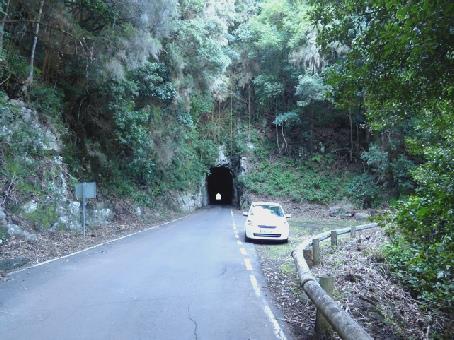

Hazardous driving!
We continued to Laguna de Barlovento, a circular reservoir, which was marked on the map as being a recreation area. The water was very low, and there was nobody about. We perhaps foolishly took a small road down from here which was more than steep, and we sometimes wondered if it was just a path! We joined a slightly wider road, but it was even steeper - first gear all the way, with the brakes on! The area was dotted with houses, but it was with relief that we joined the main road at La Cuesta!
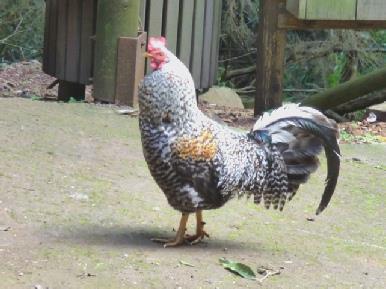

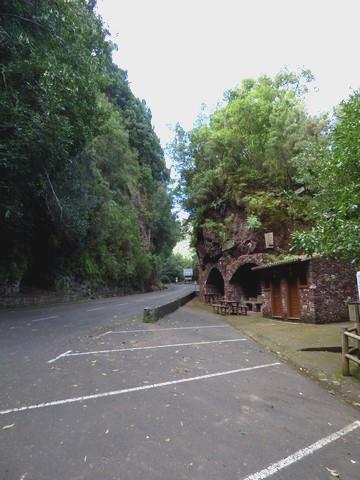
A fun picnic area
Almost immediately, we turned off onto a road between the banana groves high above the coast. We passed the lighthouse, stopping just afterwards at a viewpoint where we looked down to the turquoise water crashing onto the black rocks. There was a sheltered picnic table surrounded by a low wall – a perfect place to eat our lunch.
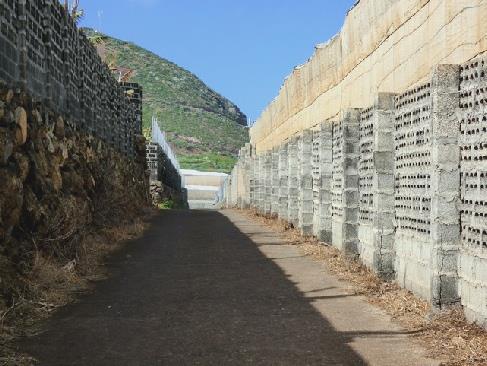
A typical road through the banana groves, with high walls and netting
In the extreme north east of the island, at Fajana, we came to pools set into the rock. There is no beach here, so this has to suffice! It was a well kept area set above the crashing sea. It looked wonderful. There were large flat areas for sunbathing, and a few people were enjoying the water - I would love to have joined them, but Adrian wasn't very keen.

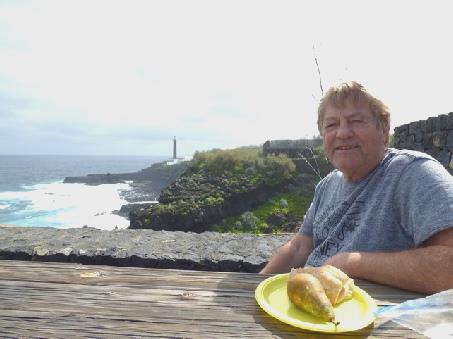

A wonderful spot for lunch!
It was a steep 1,000 ft back to the main road. We drove on through Barlovento. It was very windy when we stopped at La Tosca Mirador, where there was a dragon tree.
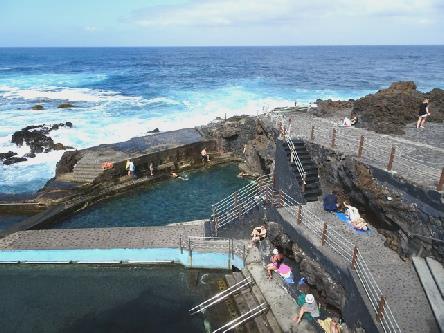
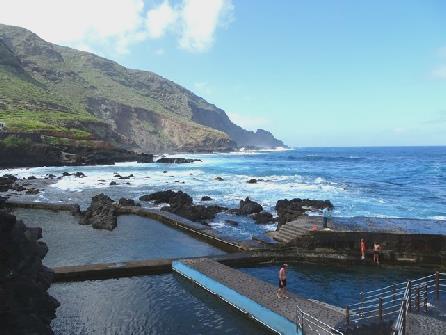
The salt water swimming pools at Fagana
We thought that we'd drive around the loop of the town of Gallegos, but we should have known that it was as far down as it was along! We were high above the sea, on tiny roads and once more in first gear all the way down and back up.
Back on the main road, we went through a long tunnel in this over-steep area.
We stopped at Parque Cultural la Zarza, known to have petroglyphs. We went into the small visitors centre, where a strange little man took our €2 each. We looked around the information about the island before walking on an often uphill and mostly rough path for about a mile to view the petroglyphs. They were of circular design, and quite difficult to see. The cloud had descended, and it now felt quite cool.
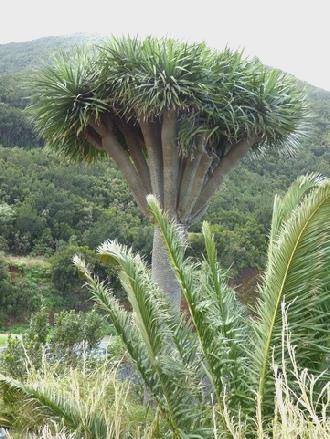
A dragon tree at la Tosca Mirador
It was after 4.00 when we set off back to Puntagorda. When we reached it, Adrian took a wrong turn, but it actually came down to the market which is held Saturday pm and Sunday morning. Cars were parked everywhere - it was a real hub. The actual market wasn't that large, but had both craft stalls and produce stalls - with one or two outside the large hall.
We bought a good loaf of bread, and some cakes and a type of courgette, but there was no fresh fish – we haven't been able to get any on La Palma. We then had to stop at the shop for some wine, and then went onto a second shop, as we realised that tomorrow is Sunday, and shops will be closed. It had now become sunny and hot again. We got back at 5.30, and relaxed with a beer and piece of the nice bread, sitting in the garden.

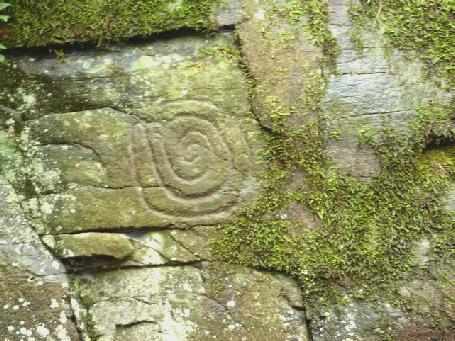
Ancient spiral petroglyphs at la Zarza
Sunday 19th February Nothing comes easy! 94Km
The morning was fine but cool. There was heavy condensation on the windows. We ate a good scrambled egg breakfast then phoned all four of our children.
We ate the rest of the cakes from yesterday, sitting outside the front door again. A new pot of flowers had been put there. As the day was fine, we changed our original plan of driving to the northwest of the island, and decided to make for the la Cumbrecita viewpoint again.
It was 2.45 when we walked back to the car. It was absolutely quiet, with hardly anybody about.
We now took a road into the mountains which had been closed the other day. Today we drove as far as the Angustias River, where the road had been washed away! As we began the return journey, we passed a couple who were desperately thumbing a lift. We stopped to drive them back to Los Llanos. They were a pleasant couple from Sweden who had just trekked 18km in this rough terrain, believing that there was a taxi service to take them back. They looked exhausted, and were so grateful for our lift.
We now took the zigzags back over the Barranco Angustias, stopping at the town of Tijarafe, where we found our way to the delightful old centre – quite bereft of people again. We walked up cobbled streets, each stone edged with moss. Pastel coloured Canarian houses with tiled roofs lined the street. There was an ancient wine press beneath the small square with its large white Virgen de Candelaria church and its wooden balcony. This time the door was open, so we were able to peep in to see a very different baroque altarpiece.


Lunch in Los Llanos
We drove through some mizzle, or low cloud, but it was clear when we got back just after 4.30, as our house is down at 2500ft (760m)
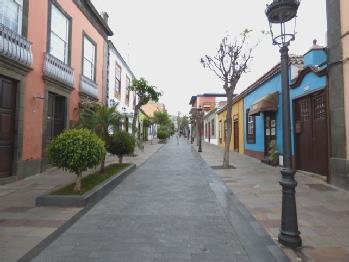

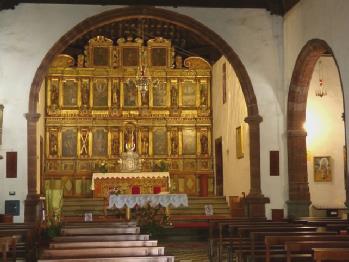
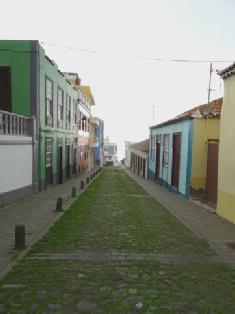
Delightful Tijarafe
We had a long skype conversation with Simon (& Millie).
Monday 20th February The former inaccessible north west coast of la Palma 58 km
It was a fine but cool morning, with a cold wind. I changed into warmer trousers. We set off to explore some of the north-west of the island, stopping first at nearby las Tricias, where a steep footpath led down to the ancient village of Buracas, where there are petroglyphs. I was reluctant even to brave the chill wind to look at the fine white church, but was glad that I did. We felt that there was a real sense of community here.
At Cueva de Agua it was more sheltered. There were flowers, cacti and succulents as we looked across to the caves set into the rock face. There were no trees here, just a thick covering of low shrubs. As always, there was a deep valley down towards the sea.
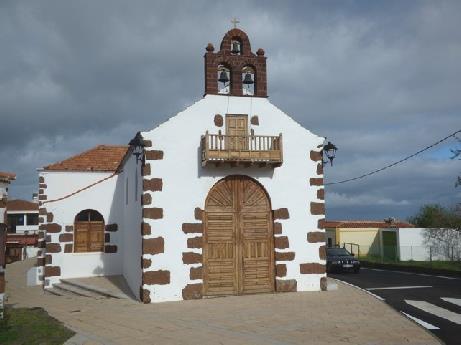
The church at las Tricias
We in fact followed a road down to the 'old port' just afterwards. It hadn't looked very winding on the map, so this meant that it was often very steep! A bit scary for me! The road stopped hundreds of feet above the sea. We sat on the edge of the tarmac to have our tea/coffee. We were surprised to see 3 people arrive and continue on the path down to the sea. We then saw that their car was parked a short way up the road, and they hadn't walked the whole way from the main road.

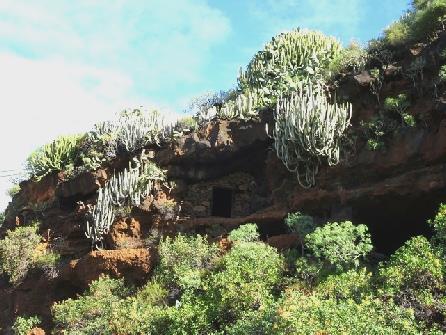
Cueva de Agua
We drove up into the hills to the actual village of Cueva de Agua then back on the main road we stopped to look at an atmospheric ancient windmill.


A nice spot for coffee, even if a bit steep!
We now came to Santa Domingo de Garafia, in the far north west of la Palma. There hadn't been a road here until 1960, so the only access had been by sea. There was a massive over-the-top football pitch, and a very grand cemetery. We took a good road down to the old port. The car park at the end of the road was quite OTT, with low walls and lots of parking, but no seats or facilities.

An atmospheric ancient windmill
We drove back up to the village, which again had a fine white church 'Virgen de la Luz' set high above the sea. It was cool and trying to rain here – there was nobody at the outside cafe.

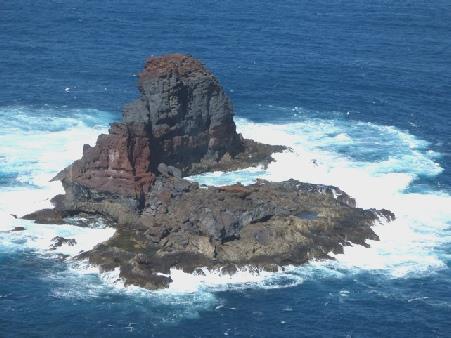
Rocky islets off Santa Domingo de Garafia
We drove up into the hills, passing another old windmill. It's interesting that there are no banana plantations at all in this area.
We ate our lunch sitting in the car before zigzagging up to Llano Negro. From here we took a too good to be true road to the hermitage church of San Antonio. There were huge pavements and a very large car park. Several young children ran out from a simple white house in the enclosure to play on the playthings in the park. A young woman joined them. We noticed that one child was wearing no trousers. We think that it was probably a small nursery. We found out later that there is a big annual festival here in June, but otherwise the area is hardly used.

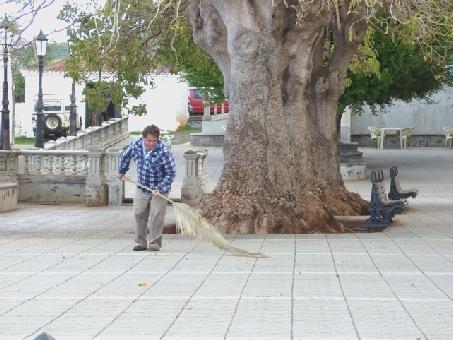
A man sweeps with a palm frond by Santa Domingo church
We now zigzagged back to Puntagorda, driving past the wooded recreation area but returning to the house to unload all our stuff. We then drove back down to walk in the woods where there were dozens of picnic tables, a play area and toilets. We couldn't imagine there ever being enough people to use all the tables.
On the way back we stopped to buy a roll for tomorrow's lunch. It was 3.00 when we got back. After a bit of sorting for our return tomorrow we sat in the sunshine in the garden with a cup of tea and some (broken) Tuc biscuits.
We ate paella for supper, with a bottle of Cava.


Children play by San Antonio Hermitage
Tuesday 21st February Lovely day as we left for England 61km
It was a fine morning as we got packed up to go home.
We had an early coffee, sitting in front of the house in the warm sunshine, slightly annoyed by a strange skinny dog with a head more like a kangaroo's!
We took the amazing road of hairpins down to the Barranco Angustias and back up, for the last time. Everywhere looked really lovely today.
We stopped at Hyperdino in El Paso, hoping to buy a sandwich, but the limited selection was no good. We took the long tunnel to Santa Cruz - it was strange entering the tunnel at what seemed ground level, going down hill through the tunnel and emerging the other side at 3,000ft (1000m) and looking straight down to Santa Cruz. We stopped again at the other Hyperdino, parking underground. Here we did find a couple of little pasties which we ate for lunch. Adrian saw fresh fish for sale here – the first time!
Now time was getting on, so we made for the airport, where we returned the car. We were dismayed to see the long queue to return the key – but most people were getting their car and so we jumped the queue and didn't have to wait too long. We had the usual problem of finding the way to check in, but all went OK. Surprisingly there was almost nobody waiting at the check in, although the flight was full.
Distance travelled – 1016 km
We went to say goodbye to Jessica, the owner, next door, who'd we'd not really seen except on the first day. She had a dear little girl Theora, 15 months old.
The visibility was marvellous as we drove south towards the airport. We stopped at the Mirador de Garome, where we'd not been able to see anything on the way up. Today the view down the gorge to the sea over 3,000ft (1000m) below was wonderful.
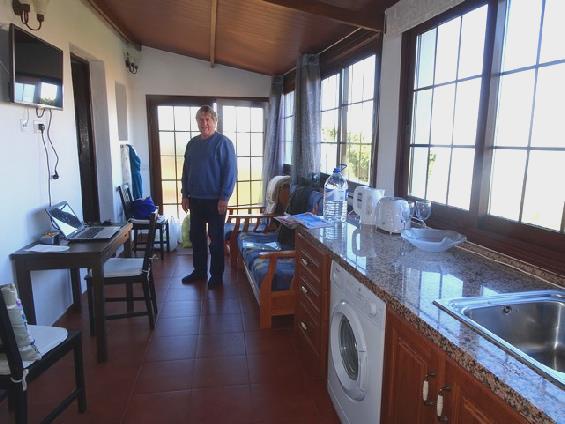
Adrian ready to leave
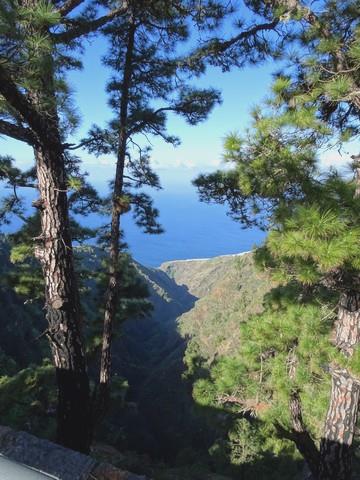
View from the Mirador de Garome
Friday 3rd February To Sitges
We left for Gatwick at 11.00am on a mild, pleasant morning. Adrian had just finished his 20 daily radiotherapy sessions for prostate cancer, so after the tedious drives to Reading, we were ready for a break!
We reached Gatwick at 12.30, where the ABC 'Meet and Greet' worked well. By now it had become windy, as forecast, so we were hoping that it didn't disrupt our flight.
We were pleased after going through security that there was a water fountain to fill our bottles.
We had asked for 'special assistance', which we usually do for me anyway (although we don't usually use it) and because of the possible fatigue which was said to be a side effect of Adrian's treatment. We thought that it would avoid the long trail to departures which we usually have. When the time came, we both got into the buggy, and were driven about a hundred yards, where we got out, and were escorted down some stairs and into an empty lounge. Our silent man waited with us. The main lounge filled up to bursting, as we discovered when I was escorted back up the stairs to the loo. We had heard that there was a delay, which they eventually said was for 'technical reasons'. Our man had expected to stay with us until we boarded, but we told him to go, as the waiting went on and on – a good couple of hours in the end.
It was after 5.00pm when we finally took off from a dark and wet airport.
The flight was sometimes bumpy because of the strong winds, and then we had another delay as the main runway at Barcelona was closed for repairs!
Luckily Tom had heard of our delay, so hadn't been waiting around all that time, but he was there to greet us and drive us back to Sitges. Mar and Rita were already asleep, so we tucked into pizza and wine, getting to bed at around midnight, which was only 11.00 to us.
We left for Gatwick at 11.00am on a mild, pleasant morning. Adrian had just finished his 20 daily radiotherapy sessions for prostate cancer, so after the tedious drives to Reading, we were ready for a break!
We reached Gatwick at 12.30, where the ABC 'Meet and Greet' worked well. By now it had become windy, as forecast, so we were hoping that it didn't disrupt our flight.
We were pleased after going through security that there was a water fountain to fill our bottles.
We had asked for 'special assistance', which we usually do for me anyway (although we don't usually use it) and because of the possible fatigue which was said to be a side effect of Adrian's treatment. We thought that it would avoid the long trail to departures which we usually have. When the time came, we both got into the buggy, and were driven about a hundred yards, where we got out, and were escorted down some stairs and into an empty lounge. Our silent man waited with us. The main lounge filled up to bursting, as we discovered when I was escorted back up the stairs to the loo. We had heard that there was a delay, which they eventually said was for 'technical reasons'. Our man had expected to stay with us until we boarded, but we told him to go, as the waiting went on and on – a good couple of hours in the end.
It was after 5.00pm when we finally took off from a dark and wet airport.
The flight was sometimes bumpy because of the strong winds, and then we had another delay as the main runway at Barcelona was closed for repairs!
Luckily Tom had heard of our delay, so hadn't been waiting around all that time, but he was there to greet us and drive us back to Sitges. Mar and Rita were already asleep, so we tucked into pizza and wine, getting to bed at around midnight, which was only 11.00 to us.
3rd-8th February In Sitges
We spent a few happy days in Sitges with Tom, Mar and Rita - now a competent and determined 3½ year old.
We walked to school one day with her and Mar - yes, they start school at three here. We also went with Tom to watch her swimming lesson, in a small pool at a gym club in the centre of Sitges. It was lovely to see how confident Rita is in the water. On the way she saw and greeted friends everywhere.
We had a wonderful lunch with Mar's dad and his wife at their apartment in Vilanova and also had visits from Mar's mum, and her brother and family - partner Elena and Noah (3½ and Rita's great buddy) and Theo, a very alert little 3 month old baby.
We enjoyed some warm sunshine amidst the often windy weather, and some great food (and drink!)
We spent a few happy days in Sitges with Tom, Mar and Rita - now a competent and determined 3½ year old.
We walked to school one day with her and Mar - yes, they start school at three here. We also went with Tom to watch her swimming lesson, in a small pool at a gym club in the centre of Sitges. It was lovely to see how confident Rita is in the water. On the way she saw and greeted friends everywhere.
We had a wonderful lunch with Mar's dad and his wife at their apartment in Vilanova and also had visits from Mar's mum, and her brother and family - partner Elena and Noah (3½ and Rita's great buddy) and Theo, a very alert little 3 month old baby.
We enjoyed some warm sunshine amidst the often windy weather, and some great food (and drink!)
Wednesday 8th February To La Palma, and our house - at the third attempt! 35km
The alarm went at 6.15 after a sleepless night for me. It was damp as we left an hour later with Tom, who was driving us to Barcelona airport before returning to teach at his school in Castelldefels. We turned off the motorway when there was a hold up, but arrived in good time at the airport.
We said our goodbyes to Tom before facing the long zigzag to 'bag drop' (not automatic here) and the long walk. We hadn't seen any 'special assistance', which I would have been glad of here. On the plane, one of the flight attendants did ask us about it.
Our flight took off on time at 9.55. We were surprised that it was scheduled to be 3½ hours, but in fact we landed 20 minutes early. We really missed not having a flight map, like on longer flights, especially when we flew over the snow topped Sierra Nevada, and later over the coast.
It was announced that it was 12.10, the same as English time, when we landed at Santa Cruz de la Palma, although our flight schedule had said 1.10. We had glimpsed Mt Teide on Tenerife before landing at la Palma's airport, right beside the sea.
We climbed back up and continued on the road up the western side. We were coming into banana country. There were plantations everywhere, many of them netted, which wasn't attractive.
Further up the coast we came to Punta Larga, a pretty black lava cove, where huge ultramarine waves crashed onto the rocks and the shore. There were a couple of simple fishing boats and several shack type dwellings. A small restaurant stood at the back of the cove. The nearby toilets were remarkably clean and well kept. We'd brought some lunch things with us, but decided to try out the restaurant.
The tables were made of beer barrels, and the seating was upright logs topped by splodgy cushioning, looking like mushrooms. Adrian's calamari was excellent, my fish croquettes 'interesting' and the chips very good. Adrian had asked for a large beer with two glasses, but we were brought two large beers! There was a big bowl of bananas, with a sign saying ‘free to customers’. It became a bit windy as we sat there, and we were annoyed at people smoking. Tourists on la Palma seem to be predominantly German.
Further up the coast we came to Punta Larga, a pretty black lava cove, where huge ultramarine waves crashed onto the rocks and the shore. There were a couple of simple fishing boats and several shack type dwellings. A small restaurant stood at the back of the cove. The nearby toilets were remarkably clean and well kept. We'd brought some lunch things with us, but decided to try out the restaurant.
The tables were made of beer barrels, and the seating was upright logs topped by splodgy cushioning, looking like mushrooms. Adrian's calamari was excellent, my fish croquettes 'interesting' and the chips very good. Adrian had asked for a large beer with two glasses, but we were brought two large beers! There was a big bowl of bananas, with a sign saying ‘free to customers’. It became a bit windy as we sat there, and we were annoyed at people smoking. Tourists on la Palma seem to be predominantly German.
As we drove on to Santa Cruz, every available piece of land was used to grow bananas – the largest source of income on the island.
Santa Cruz, the capital of La Palma, is pleasantly situated beside the sea, squashed into narrow valleys beneath the high mountains. We managed after a while to find a 'blue badge' space to park in before walking down the main street until we came to the municipal market. Like Mazo, this was quite small. There was a stall selling drinks made from fresh sugar cane – the former crop grown on the island.
From here we wandered down pedestrianised Calle O'Daly, named after an Irish banana magnate. At Plaza de Espana we looked into El Salvador church which had a beautiful coloured wooden carved ceiling.
Santa Cruz, the capital of La Palma, is pleasantly situated beside the sea, squashed into narrow valleys beneath the high mountains. We managed after a while to find a 'blue badge' space to park in before walking down the main street until we came to the municipal market. Like Mazo, this was quite small. There was a stall selling drinks made from fresh sugar cane – the former crop grown on the island.
From here we wandered down pedestrianised Calle O'Daly, named after an Irish banana magnate. At Plaza de Espana we looked into El Salvador church which had a beautiful coloured wooden carved ceiling.
We spoke to Nicky on the phone, and later to all of them on skype. We were very upset to hear that Nicky's mum is very ill.
Adrian looked into flights to see both Tom & Simon in May and later booked them. We also looked into a steam train ride in August, as there was a big reduction today, being Valentines Day. He booked that too, but had to phone in the morning to finish the transaction.
The owners called in - a very pleasant couple. They were interested to know how we got on, as this was the first booking here.
After Santa Cruz, we had to drive through several tunnels through the massive 'fingers' of steep green ravines. It felt a bit like driving through Northern Italy.
We stopped at 2 viewpoints - at the first, 'Carmen', we looked back to Santa Cruz.
We headed for the rainforest area of Los Tilos. The ravines here were enormous and vertical., reminding us of the Marquesas. Everywhere was forested, apart from the plantations of bananas growing in any available spot - sometimes even on terraces in the really steep bits.
We stopped at the Visitors Centre and went in to look at the information. Outside was a Canary bellflower, and Adrian saw several Canary chaffinches when we ate our sandwiches for lunch, sitting precariously above a low wall. We could hear the Canary doves cooing.
We thought that we'd attempt some of the 'gentle uphill walk' described in our notes. Gentle, my foot! It was a real puff! We came to a tunnel, where we turned around and descended.
We stopped at 2 viewpoints - at the first, 'Carmen', we looked back to Santa Cruz.
We headed for the rainforest area of Los Tilos. The ravines here were enormous and vertical., reminding us of the Marquesas. Everywhere was forested, apart from the plantations of bananas growing in any available spot - sometimes even on terraces in the really steep bits.
We stopped at the Visitors Centre and went in to look at the information. Outside was a Canary bellflower, and Adrian saw several Canary chaffinches when we ate our sandwiches for lunch, sitting precariously above a low wall. We could hear the Canary doves cooing.
We thought that we'd attempt some of the 'gentle uphill walk' described in our notes. Gentle, my foot! It was a real puff! We came to a tunnel, where we turned around and descended.
The morning started very grey, with a really weird and unreal looking sky. There was no view of La Gomera, El Hierro or Mt Teide this morning!
We got packed up and left at 10.15. This place had been perfect apart from the weather!
We got packed up and left at 10.15. This place had been perfect apart from the weather!
We now took a minor road, which ended up in banana groves. It was really quiet when we ate our lunch, sitting on rough stones.
We rejoined the main road at El Jesus before crossing dramatic Barranco El Jorado, where we were again in mizzle, or perhaps cloud.
Mirador El Garone would have been amazing if we could have seen anything, as it went vertically down for a very long way.
We now reached Puntagorda, where we are going to be staying, and located the house. We were too early, as it was 2.30, and we had agreed to arrive between 4.00 and 5.00.
We decided to drive to the coast, and zig-zagged down steeply for 4.4 miles, where the road ran out. From here it was still hundreds of feet vertically down to the sea. There were steps going down, with a broken fence - not for me! Down another steep slope there was a shack built into the rocks, presumably where somebody lived. We wondered why anybody would bother to build a road down to this spot, but it turned out that before the main road was built to Puntagorda in the 1950's, this 'port' was the only connection with the outside world and people must have walked down the 4 miles and 700m to reach it!
We rejoined the main road at El Jesus before crossing dramatic Barranco El Jorado, where we were again in mizzle, or perhaps cloud.
Mirador El Garone would have been amazing if we could have seen anything, as it went vertically down for a very long way.
We now reached Puntagorda, where we are going to be staying, and located the house. We were too early, as it was 2.30, and we had agreed to arrive between 4.00 and 5.00.
We decided to drive to the coast, and zig-zagged down steeply for 4.4 miles, where the road ran out. From here it was still hundreds of feet vertically down to the sea. There were steps going down, with a broken fence - not for me! Down another steep slope there was a shack built into the rocks, presumably where somebody lived. We wondered why anybody would bother to build a road down to this spot, but it turned out that before the main road was built to Puntagorda in the 1950's, this 'port' was the only connection with the outside world and people must have walked down the 4 miles and 700m to reach it!
We were greeted by Jessica, the young woman owner who lives next door. She seemed very pleasant, and spoke some English. After showing us around, she brought us a plate of biscuits, which we sampled soon afterwards with a cup of tea, sitting in the last bit of sun in the yard/garden. Opposite was an orange grove. The soil around was red, waiting to be planted. Behind us were pine trees, and we could see down to the sea. There were pots of plants all around, including an orchid in flower.
We brought in all our stuff and got settled. The house had a long kitchen diner, a double room, a spare room, and a small shower/toilet.
It was all very clean and pleasant.
We sat outside with our aperitifs, as the cloud descended down.
We brought in all our stuff and got settled. The house had a long kitchen diner, a double room, a spare room, and a small shower/toilet.
It was all very clean and pleasant.
We sat outside with our aperitifs, as the cloud descended down.
When we left at 11.30, we were both wearing shorts!
As the day was so clear, Adrian decided that today was the day to drive up to Roque de los Muchachos, the highest point on the island, where there is an observatory.
We drove through green and pretty pine forests, with a few deciduous trees. It seemed to be continual hairpin bends, as we rose higher and higher. Not the best terrain for me! We didn't reach the top until 12.40 – it was only about 28km!
Just before the summit, we encountered a gigantic coach coming the other way – not nice!
We then came to a small carpark, which was crowded out, with many more cars parked along the roadside. I couldn't believe that so many other people had followed this tortuous route. Obviously the fine weather had encouraged people out.
We had to fight our way to find a space to park. It was all much too steep and vertiginous for me. After a brief look outside, we ate our lunch in the car before walking out to the nearby viewpoints. We were at 2426m (8000ft), and could look right down into Taburiente Caldera. There were walks in all directions – all really steep of course. I felt a bit inadequate, as I could never attempt any, and was surprised how many people did.
There wasn’t just one observatory, they were everywhere – including the largest in Europe, as the skies here are so clear, away from all the bright European lights.
As the day was so clear, Adrian decided that today was the day to drive up to Roque de los Muchachos, the highest point on the island, where there is an observatory.
We drove through green and pretty pine forests, with a few deciduous trees. It seemed to be continual hairpin bends, as we rose higher and higher. Not the best terrain for me! We didn't reach the top until 12.40 – it was only about 28km!
Just before the summit, we encountered a gigantic coach coming the other way – not nice!
We then came to a small carpark, which was crowded out, with many more cars parked along the roadside. I couldn't believe that so many other people had followed this tortuous route. Obviously the fine weather had encouraged people out.
We had to fight our way to find a space to park. It was all much too steep and vertiginous for me. After a brief look outside, we ate our lunch in the car before walking out to the nearby viewpoints. We were at 2426m (8000ft), and could look right down into Taburiente Caldera. There were walks in all directions – all really steep of course. I felt a bit inadequate, as I could never attempt any, and was surprised how many people did.
There wasn’t just one observatory, they were everywhere – including the largest in Europe, as the skies here are so clear, away from all the bright European lights.
We left at 11.15, driving south towards Tazacorte, where there was virtually no water in the river Angustias – no wonder everybody was looking the other day.
At Argual there was a busy street market. We drove through Los Llanos, taking the steep road again to El Paso. We had planned to eat out today, and had chosen a restaurant in El Paso. We decided not to stop now, as the weather was clear, so we made for la Cumbrecita. We drove up the road into the forest, coming to a kiosk where the dour man asked for our tickets. We hadn't known about tickets, but it appears that only 20 cars are allowed at a time, until 4.00, when it is open for all to drive. We couldn't work out the logic of it, but returned to the visitors centre to find out. Nothing really worked for today, so we agreed to try to book a 'place' for Tuesday, on our way to the airport. When we returned to our house in the afternoon, Adrian immediately tried to book on the internet. After filling in all kinds of information, such as passport number, he then had to put nationality. All names of countries were in Spanish. There were all sorts of obtuse countries, but we couldn't find anything we recognised as being England or Great Britain (it’s actually Reino Unido but we had forgotten. You would think it would be put in in the language of the country of the person looking for it!). We then found that you had to print 2 tickets – how? most tourists don't have access to a printer. We gave up at this point – some things just don't work out!
At Argual there was a busy street market. We drove through Los Llanos, taking the steep road again to El Paso. We had planned to eat out today, and had chosen a restaurant in El Paso. We decided not to stop now, as the weather was clear, so we made for la Cumbrecita. We drove up the road into the forest, coming to a kiosk where the dour man asked for our tickets. We hadn't known about tickets, but it appears that only 20 cars are allowed at a time, until 4.00, when it is open for all to drive. We couldn't work out the logic of it, but returned to the visitors centre to find out. Nothing really worked for today, so we agreed to try to book a 'place' for Tuesday, on our way to the airport. When we returned to our house in the afternoon, Adrian immediately tried to book on the internet. After filling in all kinds of information, such as passport number, he then had to put nationality. All names of countries were in Spanish. There were all sorts of obtuse countries, but we couldn't find anything we recognised as being England or Great Britain (it’s actually Reino Unido but we had forgotten. You would think it would be put in in the language of the country of the person looking for it!). We then found that you had to print 2 tickets – how? most tourists don't have access to a printer. We gave up at this point – some things just don't work out!
We returned to El Paso, and with difficulty located the tapas restaurant beside a little church on the square, mentioned in Lonely Planet, but it was all shut up, even though the sign said open on Sundays!
I found another restaurant mentioned in nearby Los Llanos, so we made our way there, taking a wrong road because of road closures. This restaurant was closed up too! And so was the next one mentioned!
We decided to walk down to the Plaza Espana, as there were other eating places there. All were outside cafes, and it had become quite chilly. We passed the large Remedios church with its doors open. I wanted to peep inside, but Adrian said 'on the way back', as he desperately needed the loo! Having used a toilet in one of the cafes, we walked back past the church, whose doors were now firmly shut!
We had success in the end, at a little outside cafe on the square, after Adrian had gone back to the car for my fleece! I ate fish soup, and Adrian had 'fish of the day', and we both had a local beer. It was quite atmospheric, with the giant Indian Laurel trees in the square (for shade against the heat!)
I found another restaurant mentioned in nearby Los Llanos, so we made our way there, taking a wrong road because of road closures. This restaurant was closed up too! And so was the next one mentioned!
We decided to walk down to the Plaza Espana, as there were other eating places there. All were outside cafes, and it had become quite chilly. We passed the large Remedios church with its doors open. I wanted to peep inside, but Adrian said 'on the way back', as he desperately needed the loo! Having used a toilet in one of the cafes, we walked back past the church, whose doors were now firmly shut!
We had success in the end, at a little outside cafe on the square, after Adrian had gone back to the car for my fleece! I ate fish soup, and Adrian had 'fish of the day', and we both had a local beer. It was quite atmospheric, with the giant Indian Laurel trees in the square (for shade against the heat!)
We reached our departure lounge, and were very soon called to board. We went onto the plane really early, so were hoping that we would take off on schedule or before. Not so! We waited and waited. Eventually the pilot announced that we were waiting for a passenger who had mistakenly had her flight cancelled by a friend. After 40 minutes we took off, but the woman never arrived. As there is only one flight a week to Gatwick, we hope that she found another route.
On the flight, we spent some of our time reading and editing our trip to SW USA in 2003, which we haven't ever put on the website. It passed the time well!
The flight attendants took an absolute age with the food trolley so we were glad that we had our own sandwiches which we'd made this morning.
We landed at 7.30, and were asked to wait for 'special assistance'. We then had a trip by minibus, and afterwards in a buggy, so were glad not to have the long walk. At passport control, we were treated quite 'royally', and missed all the zigzag queueing.
We still arrived before other passengers at baggage collection and before the luggage had.
We stopped to buy a sandwich from M&S before making our way to 'Meet and Greet', where we did have to wait a few minutes.
It was 8.45 when we set off for Hermitage, arriving just before 10.30pm.
We'd enjoyed our time away, but the steepness of La Palma and the continually winding roads made it not the best place for me. It is certainly 'La Isla Bonita', the beautiful island.
On the flight, we spent some of our time reading and editing our trip to SW USA in 2003, which we haven't ever put on the website. It passed the time well!
The flight attendants took an absolute age with the food trolley so we were glad that we had our own sandwiches which we'd made this morning.
We landed at 7.30, and were asked to wait for 'special assistance'. We then had a trip by minibus, and afterwards in a buggy, so were glad not to have the long walk. At passport control, we were treated quite 'royally', and missed all the zigzag queueing.
We still arrived before other passengers at baggage collection and before the luggage had.
We stopped to buy a sandwich from M&S before making our way to 'Meet and Greet', where we did have to wait a few minutes.
It was 8.45 when we set off for Hermitage, arriving just before 10.30pm.
We'd enjoyed our time away, but the steepness of La Palma and the continually winding roads made it not the best place for me. It is certainly 'La Isla Bonita', the beautiful island.
A few points about La Palma
It is all very steep and winding and extremely high – the main road LP1 runs round the island at a height never less than 1000m (3000ft)
There are very few beaches
Not much tourist development
Bananas are grown in every possible space
Dozens of well-marked footpaths, but all steep
Roads are well surfaced
No motorways
Fresh fish almost impossible to find.
The island is very green – guess why?
It is all very steep and winding and extremely high – the main road LP1 runs round the island at a height never less than 1000m (3000ft)
There are very few beaches
Not much tourist development
Bananas are grown in every possible space
Dozens of well-marked footpaths, but all steep
Roads are well surfaced
No motorways
Fresh fish almost impossible to find.
The island is very green – guess why?
La Palma, Canary Islands 2017







